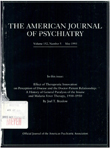Cortical-striatal-thalamic circuits and brain glucose metabolic activity in 70 unmedicated male schizophrenic patients
Abstract
OBJECTIVE: The cortical-striatal-thalamic circuit modulates cognitive processing and thus may be involved in the cognitive dysfunction in schizophrenia. The imaging of metabolic rate in the structures making up this circuit could reveal the correlates of schizophrenia and its main symptoms. METHOD: Seventy male schizophrenic patients underwent [18F]-fluorodeoxyglucose positron emission tomography after a period of at least 4 weeks during which they had not received neuroleptic medication and were compared to 30 age-matched male normal comparison subjects. RESULTS: Analyses revealed decreased metabolism in medial frontal cortex, cingulate gyrus, medial temporal lobe, corpus callosum, and ventral caudate and increased metabolism in the left lateral temporal and occipital cortices in the schizophrenic cohort. Consistent with previous studies, the schizophrenic group had lower hypofrontality scores (ratios of lateral frontal to occipital metabolism) than did comparison subjects. The lateral frontal cortical metabolism of schizophrenic patients did not differ from that of comparison subjects, while occipital cortical metabolism was high, suggesting that lateral hypofrontality is due to abnormalities in occipital rather than lateral frontal activity. Hypofrontality was more prominent in medial than lateral frontal cortex. Brief Psychiatric Rating Scale (BPRS) scores, obtained for each schizophrenic patient on the scan day, were correlated with regional brain glucose metabolic rate. Medial frontal cortical and thalamic activity correlated negatively with total BPRS score and with positive and negative symptom scores. Lateral frontal cortical metabolism and hypofrontality scores did not significantly correlate with negative symptoms. Analyses of variance demonstrated a reduced right greater than left asymmetry in the schizophrenic patients for the lateral cortex as a whole, with simple interactions showing this effect specifically in temporal and frontal cortical regions. CONCLUSIONS: Low metabolic rates were confirmed in medial frontal cortical regions as well as in the basal ganglia, consistent with the importance of the cortical-striatal-thalamic pathways in schizophrenia. Loss of normal lateralization patterns was also observed on an exploratory basis. Correlations with negative symptoms and group differences were more prominent in medial than lateral frontal cortex, suggesting that medial regions may be more important in schizophrenic pathology.
Access content
To read the fulltext, please use one of the options below to sign in or purchase access.- Personal login
- Institutional Login
- Sign in via OpenAthens
- Register for access
-
Please login/register if you wish to pair your device and check access availability.
Not a subscriber?
PsychiatryOnline subscription options offer access to the DSM-5 library, books, journals, CME, and patient resources. This all-in-one virtual library provides psychiatrists and mental health professionals with key resources for diagnosis, treatment, research, and professional development.
Need more help? PsychiatryOnline Customer Service may be reached by emailing [email protected] or by calling 800-368-5777 (in the U.S.) or 703-907-7322 (outside the U.S.).



